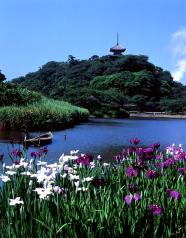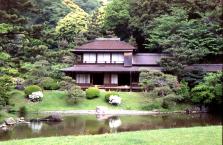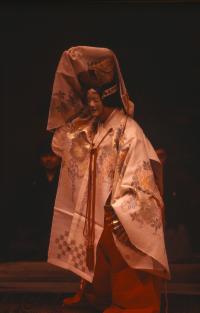Social Events
Welcome Reception
You are invited to the welcome reception at the Lounge on the 3rd floor of Pacifico Yokohama Conference Center, the DSN2005 site.
Excursion, Cultural Event and Dinner Cruise
On Thursday, June30, 2005, we will make an excursion to Sankeien Garden by buses leaving the conference site at 15:10. We then will visit a Noh Theater in Yokohama to appreciate a world-heritage "Noh" play. After this cultural event, we will go on board at Yokohama International Port Terminal to enjoy Royal Wing dinner cruise in Yokohama harbor.
- Bus Schedule
- The busses leave at 15:10 on the 1st floor of the conference site. Please proceed to the 1st floor immediately after the session. The busses return to the conference site again after the dinner cruise.
Cloak- For security reason, cloak will not open.
Cloak will open at room 421 on the 4th floor (conference venue is on the 3rd floor) for your convenience. You can check your baggage at the cloak.
-
Sankeien Garden

- Sankeien is the former residence of Hara Sankei (his real name was Hara Tomitaro), a businessman from Yokohama who made his fortune trading silk. He dismantled buildings of historic importance from places such as Kyoto and Kamakura and reconstructed them in this garden, which was opened to the public as "Sankeien" in 1906.
- In the garden, whose surface extends to 175,000m 2, seventeen old buildings of high historic value are skillfully arranged in harmony with the seasonal changes of the natural scenery.
- The Second World War caused great damage, and in 1953 the property was transferred from the Hara family to the care of the Sankeien Hoshokai Foundation. Restoration works were carried out, and five years later, Sankeien had nearly recovered its former appearance.
-
 The Outer Garden --- The extension is the area that was made
open to the general public in 1906.
The three-storied Pagoda,
relocated from Kyoto's Tomoyoji Temple, has been positioned as a
landmark, and the extension's main attraction is its many seasonal
flowers.
The Outer Garden --- The extension is the area that was made
open to the general public in 1906.
The three-storied Pagoda,
relocated from Kyoto's Tomoyoji Temple, has been positioned as a
landmark, and the extension's main attraction is its many seasonal
flowers.
- The inner Garden --- A space that compares to Katsura
Detached Palace. Until its opening to the public in 1958, this
area was the private graden of the Hara family. While the outer
garden was created for the purpose of enjoying flowers, the inner
garden is an elegant composition of old architecture.
 In particular, the landscape that includes Rinshunkaku, a pavilion
built in the middle of the 17th century (early Edo period) and that
was long related to the Kishu branch of the Tokugawa family, is
often compared with the world-famous Katsura Detached Palace in
Kyoto.
In particular, the landscape that includes Rinshunkaku, a pavilion
built in the middle of the 17th century (early Edo period) and that
was long related to the Kishu branch of the Tokugawa family, is
often compared with the world-famous Katsura Detached Palace in
Kyoto.
- Noh Play
- A Rare Opportunity to See an
Authentic Noh Play at a Traditional Noh Theater in Yokohama !
 What is a Noh Play? --- It is a 600-year-old opera form of
theater, which had been patronized by the worrier class in
Japan. It has dancing, singing, chorus and music played by three
different types of drums and a flute. Unlike western operas, all
the musicians and chorus members appear on the stage with the Noh
players.
The background scenery of the Noh is always the same; the
magnificent green pine tree. On the square Noh stage, which allows
audience to watch not only from the front but also from the side,
heroes and heroines of Noh plays travel hundreds of miles, and
often times from the past, or from the world after to present, to
tell their stories.
What is a Noh Play? --- It is a 600-year-old opera form of
theater, which had been patronized by the worrier class in
Japan. It has dancing, singing, chorus and music played by three
different types of drums and a flute. Unlike western operas, all
the musicians and chorus members appear on the stage with the Noh
players.
The background scenery of the Noh is always the same; the
magnificent green pine tree. On the square Noh stage, which allows
audience to watch not only from the front but also from the side,
heroes and heroines of Noh plays travel hundreds of miles, and
often times from the past, or from the world after to present, to
tell their stories.- A huge amount of concentration on the players' part is obvious to see on the stage. The audience, however, also enjoy watching or feeling that concentration and when every player's role, including the chorus and musicians' all get integrated harmoniously with no delay, it is one of the splendid dynamics of quiet Noh play. Noh plays are beautiful to say the least. Beautiful silk kimonos with gorgeous embroideries and exotic masks, but most of all the dancer's posture is perfect all the time and at any angle so that you can take a picture of him any time from any angle.
- Dramatic roles
- All the roles in Noh are performed by male actors.
- "Shite"
- The Shite actor is the center of attention in any play of Noh. Put very simply, the main character of Noh is the Shite. It is the Shite who is masked, which called Noh Mask, and who sings and dances. Most of the Shite is not the living human character.
- "Waki"
- In most Noh plays, the first person to appear is the Waki, the supporting character. The Waki explains the circumstances and have a dialogue with the Shite to derive the bottom of his heart. All the Waki are the living human characters.
- "Ji'utai" (the Chorus)
- The one side of the stage, which is called Ji'utaiza, sits a chorus of about eight people. Members of the chorus come from the Shite schools.
- "Koken"
- The persons who carry the set pieces on the Noh butai and wear the costume of the Shite calls the Koken. But the Koken is more than just the stage assistant. When some accident occurs, the Shite died on the stage, the Koken would perform as the Shite.
- Musicians
- The orchestra of Noh, seated at the back of the stage,
consists of four instruments.
- Nohkan : a flute
- Ko tsuzumi : a shoulder drum
- Oh tsuzumi : a hip drum
- Taiko : a large drum
-
- HAGOROMO is the Noh Play you are going to see in Yokohama. It is a story about a goddess who left her special robe on a pine tree on the beach. A young fisherman finds it and tries to leave with it. She begs him to return the robe and she says she can't go back to the heaven without the robe's magic power to fly. He says if it's such a nice robe he wants to keep it as a treasure. The goddess cries quietly and looks up to the heaven sadly. Then the fisherman gives in and returns the robe. The goddess dances beautifully expressing her joy and gratitude and flies away.
- Now don't miss the chance to see this beautiful Noh Play.
- PHOTOGRAPHING IS PROHIBITED DURING THE PERFORMANCE.
![[DSN logo]](img/DSN2005_Logo.jpg) The International Conference on Dependable Systems and Networks
The International Conference on Dependable Systems and Networks![[IEEE logo]](img/MBblue_s.gif)
 hal.rcast.u-tokyo.ac.jp>
hal.rcast.u-tokyo.ac.jp>